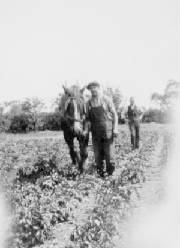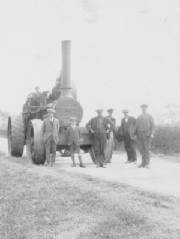|
|
The history of Braceby is synonymous with the fortunes of the village. Much of the history can only be worked out from what we can now see and the very few documents still existing. THE SOKE OF GRANTHAM & ITS IMPORTANCE IN BRACEBY'S HISTORY A Soke is an administrative area. Sokes
developed prior to the Norman Conquest, and comprised some, not
necessarily all, of the villages surrounding certain towns.
There were eleven parishes in the Grantham Soke, including Braceby. In the Domesday Book both Braceby
and the adjoining smaller parish of Sapperton were listed under land belonging to the King. A church is
mentioned. Enigmatically just where in the two parishes it was situated is not clear. Braceby
church was under the control of the Grantham mother church. The
tithes were paid to the vicar of Grantham, seven miles away.
Therefore it was the duty of the Vicar to provide a clergyman for Braceby. And this remained the
case until 1854. MEDIEVAL The
medieval layout of the village can still be seen in some village plots,
which
are long and narrow. At least two present
houses show medieval origins. The church has its
traditional
position in the centre of the village. It was
built in about 1200-1250AD. The west wall of the present church
is all that remains of the original exterior walls.
Two side aisles were built in the medieval period, but only
one now remains. The mass dial built into the
south wall of the porch is late medieval. At the creation of the protestant Church of England much of the decoration that was inside the church disappeared. The plastered walls may also have been decorated, and this decoration was covered or removed. Beautiful medieval stained windows had to be broken up, either then or later at the Civil War. Fragments have been reglazed into one window. In 1566 the Churchwarden, Nicholas Bawne, was obliged to make a sad inventory for the Diocese, confirming what had happened to church furniture and plate:- First all or mass bookes and other of the Idolatrous mass weare torne and made awaie anno po Elizabeth Item one banner clothe – made away anno po Elizabeth Item ii candelstickes an oynting box a canapie and a crosse sold to Johne Pell Anno dni 1565 and is defacid Item a crwet – or vicar that was had it awaie wth him anno po Elizabeth who is the vicar of Londonthorp Item one vestment – broken and deficid anno po Elizabeth Item iii altar stones and a hollie waterfate – broken and deficed anno pdco and is occupied about the mending of Skellington Hall Item or Rood Loft – broken and therof is made seats for the parishoners anno dni 1563 Item an alb – whereof is made a coveringe for or font Anno 1565 Item or Roode Images Marie & John - burnid – so that their remain none upon or othes
This was the heyday of Braceby. The Towne family purchased the lordship of the Manor and moved to Braceby from Heydour. They stayed over 100 years and rebuilt the Manor House. At the same time other wealthy landowners and tenants had money to spend. They improved their homes and the largest houses in the village date from this period. In the early 17th Century reports made by the clergyman of the village to the Bishop (known as Glebe Terriers) show that the glebe land amounted to a few strips in the open fields. There was a “neat vicarage house” of 3 bays. By 1671 the house was described as “blown down” and the parcels of land were in the enclosed fields. In 1690 the house “in stone and covered with thatch” was “two bays of building now in very good & sufficient repaire”. In 1700 the vicarage house was let, as the recently installed Rector of Sapperton was acting as Curate for Braceby.
In this century the church went downhill. Making a living from farming became harder. By 1724 the vicarage was once again “blown down”. In common with many other churches in Lincolnshire the South Aisle was probably demolished in the eighteenth century and the south porch repositioned on the new south wall. Certainly the barn and dovecote of Manor Farm, built about that time, include many pieces of cut stone which come from a more sophisticated building. It was at this time that the Welby family of Denton began leasing and then buying land in Braceby. They bought the lordship of the Manor and land from the Towne family, who left the area. The Welby family did not live in Braceby. They worshiped and were buried in Denton church. Gradually the side chapel fell into disrepair, with nobody having a personal interest in it.
The start of the nineteenth century found William Earle Welby, Lord of the Manor, and the Archdeacon, John Pretyman, obtaining a faculty to demolish the side chapel. This chapel was described by Edmund Turnor in his book as follows:- “The chapel communicates with the chancel by a plain circular arch. The window at the end is walled up; but the stone munions shew it to be more ancient than Henry VI, being adorned with beautiful tracery.” In a Glebe Terrier for 1822 the parish of Braceby no longer has any vicarage house or land, only the church and churchyard, still a chapelry of Grantham. The 1838 Tithe Award listed 10 landowners in Braceby. The Welby family owned more than half and others owned between 1 and 152 acres each. In 1843 sufficient funds were found to re-lead the nave roof. This lasted for over 160 years. The return made for the 1851 Census of Religious Worship reported that Braceby had 45 seats held by subscription and 25 free seats, but that only about 20 attended the fortnightly morning Service. 24 Sunday scholars sat in the Chancel. In 1854 the Diocese permitted the Welby family to receive glebe land in Sapperton in exchange for approximately 3 acres at the corner of a field in Braceby. Here a new vicarage house was built and the parishes of Sapperton and Braceby were combined into one, although administered separately, as they still are. The first Rector was Rev. William Handley Bland, already Rector of Sapperton and Curate of Braceby. He is buried in Braceby churchyard. He devoted his life to his two small parishes. The population of Braceby rose rapidly from 71 in 1801 to 155 in 1841, living in 33 houses. By 1861 there were 168 people living in 37 houses. Most were farm labourers and desperately poor. However the village did have its blacksmith, carpenter and shopkeeper as well as a schoolmistress. In 1870, well into the period of Victorian church rebuilding, the Chancel was rebuilt to a simple design by Ewan Christian, RIBA. The cost of £138 was funded by the Ecclesiastical Commissioners who were reluctant to accept their responsibility for the full costs, but eventually accepted it after correspondence with Rev. Bland. It appears that there was no money or will to do more and therefore the rest of St. Margaret’s church remains largely unchanged.
The population fell as rapidly as it had risen. In 1901 it was 77, less than half of the 1861 peak, and poverty continued. At Christmas 1901 Rev. Bland’s widow and daughter sent gifts of half a pound of tea and a warm coat to each household in the village. By 1918 Sir Charles Welby Bt. owned almost all the land in Braceby parish. Slowly the population declined. In 1950 it was agreed to apply for a faculty to repair the roof. Attempts were made to raise £600, the estimated cost. Grants were applied for, but even with these there was a £150 shortfall. It was decided to postpone the work. By 1970 the population was below 20, and Braceby was part of a Group of four parishes, with Ropsley, Sapperton and Old Somerby. Services were held twice a month. At this point a decision of the Welby family to sell empty and unwanted cottages was important in saving the church from being closed. The people who moved in had more disposable income. They strongly resisted a proposal that the church should be closed, and began to raise funds to pay for maintenance work. A two-day Village Festival held in 1982 raised enough for the interior walls to be replastered and limewashed and other repairs to be done. Repairs to the bellcote meant that the second bell could be rehung. Kneelers were worked by parishoners and friends. In 1994 upon the retirement of the
Rector the group of parishes was linked to six others in the Ingoldsby Group under one rector. *
Reference Documents:- 1971 Quinquennial Survey by Grantham Architects Bond & Read Glebe Terriers, Faculty, will of Rev. Handley Bland, documents relating to the Towne & Welby families at Lincolnshire Archives Office, Lincoln Collection for the History of the Town and Soke of Grantham by Edmund Turnor 1806 English Church Furniture, Ornaments & Decoration at the time of the Reformation Edward Peacock 1866 The Buildings of England, Lincolnshire 2nd Edition by Pevsner N. and Harris J., 1989 Lincolnshire Returns for the Census of Religious Worship 1851 ed. R.A. Ambler Lincoln Record Society 1979 |



